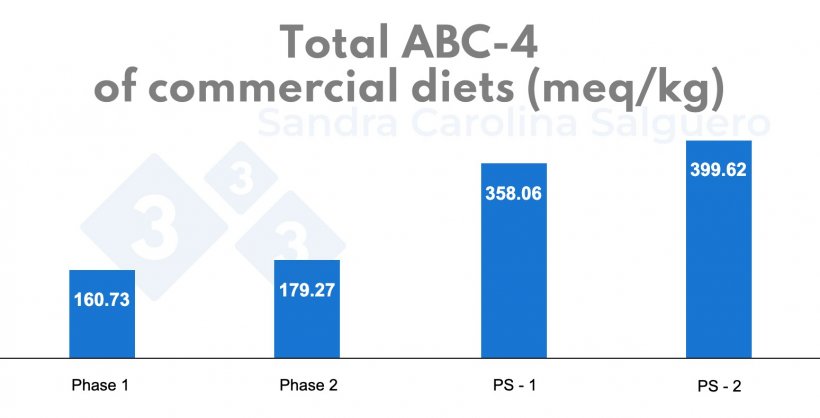Weaning represents one of the most challenging physiological and nutritional transitions in the piglet's life. The transition from a liquid, highly digestible diet to a solid, grain-rich one occurs while the digestive tract is still developing, causing physiological and metabolic vulnerability (Pluske, 2016).
During lactation, gastric pH is regulated by lactic acid produced by lactose fermentation (Cranwell et al., 1968). However, after weaning, endogenous production of hydrochloric acid is limited, causing an increase in stomach pH to values close to 5.0 (Kidder and Manners, 1978). This elevated pH reduces pepsin activity, which is key to protein digestion, and favors pathogen proliferation (Longland, 1991; Bolduan et al., 1988).

In this context, the importance of Acid Binding Capacity (ABC) arises, particularly ABC-4, defined as the amount of acid necessary to reduce the pH of 1 kg of feed to 4.0. This threshold favors optimal pepsin activity and microbiological control in the gastrointestinal tract (Lawlor et al., 2005).
ABC-4 values vary across ingredients. They are high in minerals such as calcium carbonate and zinc oxide, as well as in plant-based proteins such as soybean meal. Warner et al. (2022) have shown improvements in production performance by reducing ingredients that raise ABC-4.
Use of ABC-4 in piglet diets
Since it was proposed by Jasaitis et al. (1987), numerous studies have shown that diets with low ABC-4 favor a more acidic gastric pH. Bolduan et al. (1988) and Blank et al. (1999) reported benefits in protein digestibility and reduced diarrhea. Subsequently, research by Lawlor et al. (2005) and Gómez-Conde et al. (2012) reinforced the association between low ABC-4 and improved weight gain, feed conversion, and digestive health.
Evolution of ABC-4 in different production phases
A piglet's hydrochloric acid production capacity increases with age, allowing the ABC-4 of diets to be progressively increased. Ingredients such as cereals have low ABC-4 values (43-147 mEq/kg), while minerals such as calcium carbonate (18,384 mEq/kg) and zinc oxide (21,863 mEq/kg) have a significant alkalinizing impact (Stas et al., 2022).
In commercial practice, the first post-weaning phases use diets with low ABC-4 (Phase 1 and Phase 2), gradually increasing in pre-starter feeds (PS-1 and PS-2) to values close to 400 mEq/kg, reflecting an adaptation to the piglet's digestive development (Graph 1).

Ingredients that raise ABC-4
The ABC-4 of the diet depends directly on the ingredients used. Minerals such as zinc oxide and calcium carbonate are mainly responsible for increasing the total ABC-4, even at low inclusions. Other ingredients that have a significant impact include dicalcium phosphate and vitamin and mineral premixes. Regarding proteins, animal-based meals have high values, as does conventional soybean meal, while fermented soybean meals have considerably lower values, representing a favorable option for reducing ABC-4. On the other hand, cereals maintain low ABC-4 values, making them preferred ingredients for diets with low alkalinizing impact.
By understanding which ingredients elevate ABC-4, we can develop effective strategies for reducing it in formulations. Table 1 shows the ABC-4 of some commonly used ingredients in piglet diets (mEq/kg).
Table 1. ABC-4 of some ingredients used in piglet diets (mEq/kg). (Adapted from Stats et al., 2022 and Lawlor et al., 2005.)
| Ingredient | ABC-4 (Stas et al., 2022) | ABC-4 (Lawlor et al., 2005) |
|---|---|---|
| Corn | 84 | 111 |
| Sorghum | 110 | - |
| Wheat | - | 108 |
| Barley | 77 | 113 |
| Soybean meal | 602 | 642 |
| Extruded soybeans | 567 | - |
| Soy protein concentrate | 737 | - |
| Fermented soybean meal | 207 | - |
| Beet pulp | 151 | 191 |
| Fish meal | 1380 | 738 |
| Bovine plasma | 713 | - |
| Spray-dried serum | 440 | - |
| Skim milk | - | 756 |
| Permeate | 520 | - |
| Lactose | 53 | - |
| Calcite | 18384 | 12932 |
| Zinc oxide | 21863 | 16321 |
| Monocalcium phosphate | 73 | - |
| Dicalcium phosphate | 2693 | 3098 |
| Salt | 15 | 83 |
| Sodium bicarbonate | - | 12566 |
| Vitamin premix | 10767 | - |
| Mineral premix | 7867 | - |
| Choline chloride | 40 | 101 |
| L-lysine | 83 | 123 |
| Dl-methionine | 137 | 192 |
| L-threonine | 160 | 218 |
| L-tryptophan | 120 | 179 |
| L-valine | 193 | - |
| Fumaric acid | - | -10862 |
| Formic acid | - | -13550 |
| Citric acid | - | -56.5 |
| Lactic acid | - | -7214 |
| Acetic acid | - | -5079 |
| Propionic acid | - | -2283 |
Strategies to reduce ABC-4
Various nutritional strategies can reduce the ABC-4 of diets:
- Partial substitution of soybean meal: Using fermented or enzymatically treated soy protein concentrates significantly decreases the ABC-4 of the diet (Stas et al., 2022).
- Reduction/withdrawal of pharmacological zinc oxide: This practice not only reduces ABC-4 but also complies with health regulations in several countries.
- Alternatives to calcium carbonate: Reducing or partially substituting with other calcium sources improves the gastric environment, as demonstrated by Warner et al. (2022).
- Strategic use of acidifiers: Incorporating organic acids such as formic, citric, or lactic compensates for the alkalizing effect of certain ingredients.
Relationship between ABC-4 and productive performance
Numerous studies support the positive relationship between ABC-4 reduction and piglet productive performance. Batononon-Alavo et al. (2016) and Warner et al. (2022) evidenced improved daily weight gain and feed efficiency through strategies that reduce ABC-4.
Several mechanisms may explain these positive effects. A lower gastric pH favors:
- Increased protein digestibility: By enhancing pepsin activity.
- Better intestinal health: By decreasing the risk of infections and diarrhea.
- Increased gastrointestinal development: By promoting the production of digestive enzymes and the growth of intestinal villi.
- Positive modulation of the intestinal microbiota: Promoting beneficial bacteria.
However, it is important to recognize that the relationship between ABC-4 and productive performance is influenced by multiple factors, such as animal health status, environmental conditions, and overall diet composition. Together, these improvements may explain the increases observed in daily weight gain and feed efficiency reported in different studies.



